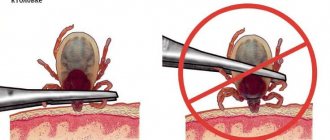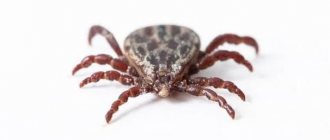With the onset of the warm season, the number of diseases caused by tick bites in cats increases sharply. With the onset of spring, pet owners begin to worry about how to protect their pet from this problem by any means. A tick bite in itself is not so terrible for a cat; dangerous pathogens are contained in the tick’s saliva, which can cause a number of dangerous and sometimes fatal diseases for a cat. Cats that walk through tall grass or dense bushes are especially at risk, where they are especially likely to pick up ticks. The tick that has just attached itself to the cat's skin is about the size of a pinhead. Over time, after he drinks blood, he grows to the size of a bean and is impossible not to notice.
General information about ticks. Ticks (Acarina) are small (0.1-30 mm) arthropods of the arachnid class (Arachnoidea) belonging to the largest group in the arthropod subclass, their number reaches 50 thousand species, most of which do not cause any harm to humans and animals. Ticks that parasitize cats are usually classified as carnivorous parasites, leading to the development of allergies, dermatitis, bacterial and viral diseases. Some ticks that attack cats drink blood, others chew the skin, and others feed on skin secretions and lymph. Cats are most often parasitized by three types of ticks:
Ixodidae (Ixodidae) are the largest ticks, which in a hungry state reach 2-3 mm in length, and after sucking blood - up to 1-1.5 cm. Scabies (internal, ear).
Subcutaneous (demodectic).
Mouth organs (piercing, gnawing, cutting, sucking). In all ticks they are formed by the first two pairs of limbs, chelicerae and pedipalgi; in ixodid ticks they consist of a pair of cutting chelicerae and a hypostome (an outgrowth of the lower edge of the mouth opening, covered with spines), tracheal or cutaneous respiration. Eyes are usually absent, less often there are 1-2 pairs. The stomach is saccular, in blood-sucking ticks with blind outgrowths that fill with blood during blood sucking. The excretory organs are represented by a pair of Malpighian vessels. Blood-sucking ticks have well-developed salivary glands, the secretion of which prevents blood clotting. All ticks are dioecious. The difference between females and males is well expressed, fertilization is internal. Most ticks are oviparous. The six-legged larva is the most characteristic feature of ticks.
The life of a tick can be roughly divided into four stages: egg, larva, nymph and adult. The total lifespan of a tick is about two months. After the tick drinks blood, it falls off and the larva begins to molt. Subsequently, the larva moves to the next stage of development, becoming a nymph; the nymph molts, turning into an adult tick, which is capable of leaving behind offspring. Ticks reproduce thanks to the female's ability to lay eggs. Considering that ticks that attack a cat multiply quickly and create optimal conditions for the development of bacteria and viruses, the owner should not delay treating the cat for ticks.
The process of a tick attacking a cat . Hungry ticks find their prey thanks to the presence of special thermal sensors. A cat passing by a bush or grass on which a tick is sitting becomes an object of attack; the tick makes a jump and, clinging to the hair, remains on the cat. Having latched onto a cat, the tick begins to look for a place on the body that is least covered with hair (skin around the ears, neck, legs, abdominal area, etc.). Further digging into the skin with its tentacles, the tick pierces the skin and begins the process of sucking blood. It becomes almost impossible to tear it away from the cat at this time, and only after the tick has completely drunk blood does it fall off the cat’s skin.
General information about ticks that parasitize cats
Between the end of May and the beginning of July, all warm-blooded animals are at risk of being attacked by dangerous parasites, an encounter with which can lead to dire consequences. This threat also applies to cats.
At this time, mites are activated - representatives of the class of arachnids, a subclass of arthropods. To date, more than 50 thousand species of these bloodsucking creatures have been described. Three main types of ticks pose a particular danger to cats:
- ixodid;
- ear;
- subcutaneous.
Ixodid ticks live and lie in wait for their victims in grass and low bushes. Even a domestic cat can be bitten by a bloodsucker. Therefore, after a walk around the garden or on the lawn, the animal must be carefully examined. A detected tick should be immediately removed and destroyed.
Ixodid ticks prefer to attach themselves in places that are difficult for the animal to reach - on the back, stomach, joint bends, and armpits. The skin there is more tender, and the cat will not be able to reach it.
Owners' fears that a cat may die from a tick bite are not unfounded. The parasite's saliva can transmit pathogens of dangerous diseases. Also, the condition of a bitten cat can be complicated by a secondary infection.
Ear mites, despite their small size (smaller than a grain of semolina), can cause great trouble not only for a cat, but also for other pets. It is easy to become infected by contact with a carrier, but curing a cat from this scourge is not so easy.
Subcutaneous mites are no less dangerous. They choose the upper layers of the cat's skin as their habitat and become the cause of its suffering. Ticks gnaw passages in the skin and feed on the tissues and blood of the animal, which causes unbearable itching.
Small kittens and cats over 7 years old are especially defenseless against tick attacks and the consequences of their pathological influence.
It does not matter what type of mites the cat is infected with. The first task when an infestation is detected is to get rid of the parasite and immediately begin adequate treatment.
Ixodidae
The Ixodid tick is the most common type of parasite and the largest. It has an oval body, which is covered with a chitinous shell, 8 legs and a disproportionately small head. The carapace covers about one third of the insect's body, which allows the elastic abdomen to expand 3 times when filled with the blood of the attacked animal. The main weapon of a tick is its proboscis with hooks (similar to fishing hooks), which allow it to gain a foothold in the body of the victim. Ticks remain on the animal from several days to 1 month.
At the moment of the bite, the tick injects a secret agent under the skin - saliva, which has an anesthetic effect. Therefore, the cat does not feel when ticks bite her, and gives the parasites time to securely attach themselves to the skin. After this, the tick on the cat begins to eat - it gains access to small blood vessels and sucks blood.
The flat black or dark brown body of the insect swells as it becomes saturated and looks like a large bead. The color also changes - from pinkish-gray to red and brown.
After satiation, the male tick detaches and goes to rest in a secluded place, and the female lays eggs in the wound and dies.
Why is a bite dangerous?
The danger of a tick bite is that these parasites are often carriers of dangerous viral infections:
- Lyme disease or borreliosis. It is mainly found in the European part of Russia, but recently the distribution area of the pathogen has expanded to Sakhalin. The disease passes the acute stage and immediately becomes chronic. The joints are affected and blindness can occur.
- Tick-borne hemobartenellosis of cats. Usually the disease immediately becomes chronic. The hematopoietic system is affected, and, as a result, anemia occurs (death of red blood cells). The acute form of the disease can lead to the death of the cat.
- Tick-borne encephalitis. The causative agent of the disease affects the cerebral cortex, causing its swelling. If the disease does not lead to the death of the cat, then complications await it: paralysis, epilepsy, loss of vision.
- Piroplasmosis. The pathogens enter the bloodstream. They feed on red blood cells, so a cat bitten by an infected tick quickly develops anemia. The body's protective functions are weakened, and the functioning of internal organs is disrupted. If treatment is not started on time, the cat may die.
The risk of contracting these infections is not very high, but you should be aware of it.
Stages of the disease
Encephalitis in cats has several stages of development:
- Incubation period. If the cat has a strong immune system, then this stage can develop up to two weeks. During this time, the animal will experience cold-like symptoms, including high fever and discharge from the eyes and nose.
- Neurology. During this period, damage occurs to the nervous system, or more precisely, to the neurons of the brain. The severity of the disease will influence the symptoms.
- Intoxication. In addition to damaging nerve cells, at this stage pathogenic microorganisms begin to release toxic substances leading to intoxication.
To save his cat, the owner needs to help her until she develops a severe form of intoxication and the disease affects all systems and organs.
Consequences and symptoms of a tick bite
During the period of tick activity, it is necessary to more closely monitor the behavior and well-being of the cat, especially if it is allowed to walk outside.
Characteristic signs of a tick bite in a cat:
- increase in animal body temperature;
- loss of appetite;
- apathetic behavior;
- disruption of the gastrointestinal tract - diarrhea, vomiting;
- signs of anemia are pale mucous membranes.
Some symptoms may appear immediately after a tick bite, others after 2-3 weeks.
When alarming signals appear, the cat owner should not immediately fall into despair - these signs are not always symptoms of dangerous fatal diseases. This may be an allergy that was triggered by a tick bite, or another reason.
A cat can pick off a parasite, but leave its head in the skin. This can cause suppuration of the wound and further infection when scratching. Therefore, ticks should be removed carefully and carefully.
Only a specialist can understand the causes of a cat’s illness and protect it from the adverse effects of tick bites.
Symptoms of encephalitis
Encephalitis in cats is a serious pathology and the sooner the animal’s owner detects its signs, the more chances he will have to save the animal.
Encephalitis in cats is presented by a number of signs that depend on the severity of the disease. In the first few weeks after infection, your pet will develop:
- fever accompanied by an increase in temperature;
- apathy, drowsiness and lethargy;
- various changes in behavior that are not typical for a pet;
- lacrimation and mucus discharge from the nose;
- diarrhea and vomiting;
- refusal to eat.
If the symptoms are ignored, the disease will progress to the next stage, which is characterized by:
- paralysis and weakening of limbs;
- blindness and deafness;
- convulsive syndrome;
- tremor of the limbs and lower jaw;
- impaired coordination of movements;
- tension in the neck muscles with the inability to tilt the head forward;
- headache;
- dehydration and sudden weight loss.
"Note! If the pathology is caused by a tick bite, then it can proceed much faster, and the first symptoms may appear after a few hours.”
How to properly remove a tick
First, you should familiarize yourself with the information about what not to do if your cat is bitten by a tick:
- pour oil over the parasite and coat it with Vaseline: yes, the tick will die, but it will remain in the wound and cause tissue inflammation;
- use tweezers: squeezing the tick’s abdomen will lead to the release of the entire volume of parasite saliva into the cat’s blood, and with it, infection;
- use a loop of thread to remove the bloodsucker: there is no guarantee that the head of the tick will not remain in the wound.
In every veterinary store or pharmacy you can purchase a special device for removing ticks - a tick twister.
You need to spread the fur, press the grip tightly against the cat’s body and pry the tick. And then carefully turn the tool and pull it towards you. It is recommended to rotate clockwise, but most likely it does not matter.
The bite site is treated with a disinfectant solution: hydrogen peroxide or chlorhexidine. Iodine and brilliant green are not suitable for delicate cat skin.
Important! All manipulations must be performed only with gloves. It is best to burn the removed tick if there is no need to take it for analysis.
The ideal option is a visit to the veterinary clinic. An experienced doctor will remove the tick, treat the wound and examine the cat. The parasite will also be examined for infections.
Interesting! The insect will fall off on its own when it is pumped with blood - after 3-5 days. In this situation, it is important to ensure that the cat does not have the opportunity to scratch the site of the tick bite.
What not to do
List of prohibited actions:
- Do not suffocate the tick with vegetable oil - the film provokes the tick to increase the release of saliva under the skin;
- You can’t douse the tick with kerosene/alcohol - the parasite won’t die, but it won’t come off, and you’ll only waste time;
- you should not deepen the wound in attempts to get it out - this way you can introduce an additional infection under the skin;
- You can’t throw a lasso of thread over a tick—you won’t get it, but you’ll definitely tear off its head.
Prevention
The most reliable guarantee for pets against tick attacks is not to let them go outside during the period when bloodsuckers are active. Kittens, pregnant and lactating cats, weakened and elderly animals need special protection.
Special medications will help prevent bloodsuckers from attacking a free-ranging cat:
- Most often these are drops that are applied to the withers - spot drops. They are good because they are not toxic to cats and do not penetrate into the blood. After applying the drug, the active component is concentrated in the sebaceous glands. For a long time, the agent is released onto the surface of the cat’s coat and provides reliable protection against bloodsuckers. One treatment per month is enough. A small drawback is that the drops are washed off with water. They should be applied no earlier than 2-3 days after washing the cat.
- Sprays are quite effective as a tick repellent. It is best to use them in conjunction with spot drops. In this case, the reliability of protection against bloodsuckers will increase several times. Disadvantage: sprays contain essential oils, the smell of which may not be pleasant to the cat.
- Pills. The veterinarian will recommend the most suitable ones for the cat depending on the age and physical shape. Validity period is one month.
- Collars. Special impregnation and gradual release of active substances guarantee reliable protection of the cat from ixodid ticks for a long time. Collars are also convenient because they can be put on or taken off as needed. It is worth mentioning that they are an original and stylish accessory.
When purchasing broad-spectrum preventive products, you should pay attention to ensure that their action specifically against ixodid ticks is stated in the annotation.
To find ticks on cats, after each walk they are carefully examined, combed out, and the fur is lifted, especially in “strategically important places”: in the armpits, on the bends of the joints, on the stomach, neck and back.
You need to understand that a cat, even at home, cannot be 100% protected from tick attacks and the risk of contracting a dangerous infection. Animal owners can carry these parasites on shoes and clothes.
An effective measure would be to observe the cat's behavior. Anxiety, attempts to bite oneself, and scratching against surrounding objects may be evidence of the presence of a tick on an animal.
Ixodid mites are dangerous only in the spring and summer, and scabies parasites are not subject to seasonal changes. A cat can suffer from them at any time of the year.
Preventive actions
To minimize the likelihood of disease, the cat owner must:
- inspect your pet after walks for ticks;
- vaccinate against viral infections;
- vaccinate against rabies;
- limit your tailed pet’s communication with homeless and wild animals;
- promptly treat diseases of the ENT organs;
- Isolate the cat if it is bitten by a wild animal in order to monitor the possible development of rabies.
- Carry out deworming every six months.
By following these recommendations, infection with encephalitis can be minimized.
Scabies
Scabies in cats, or sarcoptic mange, is a dangerous disease. Its causative agent is the microscopic mite Sarcoptes scabiei, which is equally dangerous for people and animals. The parasite settles on the surface of the skin and feeds on sebum. Females lay eggs in the upper layers of the cat's epidermis, which causes ulcers and suppuration.
The main symptom is severe itching, which cannot be relieved with antipruritic drugs. Papules form on the surface of the skin - small blisters filled with reddish contents. Their localization is along the edges of the ears, on the chest and stomach, on the elbow bends of the cat.
These symptoms are accompanied by focal baldness and ulcers. Cats often develop an allergic reaction, so it will take longer to treat your pet.
Treatment for scabies, which is usually prescribed by a veterinarian, includes:
- bathing the cat using antiparasitic drugs once a week;
- injections;
- treating affected areas of the skin with ointments and drops;
- use of antibiotics – in case of threat of secondary infection;
- taking antihistamines and immunomodulators – if necessary.
Interesting! A person can easily become infected with scabies mites. But the parasite does not reproduce on human skin. If you protect yourself from re-infection, then after the life cycle of the pathogen is completed, scabies will disappear even without treatment.
Otodectes
Otodectes cynotis - ear mites. Quite often they affect even domestic well-groomed dogs and cats. Animals can become infected from each other, but the parasite is not dangerous to humans. These mites live in the earwax and secretions of the sebaceous glands - in the ears of cats.
With the help of powerful jaws, bloodsuckers bite into the delicate skin of the animal and suck blood and intercellular fluid. They are no more than 0.6 mm in size, usually yellow.
The disease caused by these parasites is called otodectosis. First, mites settle on the inner surface of the ear, then the lesion goes deeper - into the middle ear and onto the eardrum, resulting in deafness. In advanced forms of infection, parasites can damage the membranes of the brain, and the cat dies.
The symptoms of otodectosis are very characteristic and pronounced from the very beginning of the disease, so it is not difficult to start treatment on time. The main signs of a cat having ear mites:
- restless behavior: the cat meows pitifully, shakes its head;
- signs of disorientation appear - uncertainty and unsteadiness of gait;
- the appearance of crusts and scabs from light yellow to coffee color on the inner surface of the ear;
- the cat scratches the ear area until there are scratches and sores;
- thinning of the fur around the ears;
- unpleasant odor from the cat's head, purulent discharge from the ears.
Diagnosis of the disease is quite simple - the doctor will take a scraping of discharge from the ear and send it for analysis. Full recovery occurs if the symptoms and treatment of the disease are identified in time. The doctor will prescribe a regimen and duration of therapy. Usually this is washing with an antiseptic solution and further instillation of special anti-mite drugs.
A prerequisite is cleanliness. Treatment should be long enough to completely get rid of the parasite. Drops against ear mites are recommended to be used not only during treatment, but also for prevention.
Therapy
If symptoms of encephalitis occur in a cat, it should be taken to a veterinary clinic and left under the supervision of specialists who will be able to carry out all the necessary measures and monitor its condition.
To relieve cerebral edema and prevent its development, the animal is injected with diuretics such as Veroshpiron or Furosemide, as well as potassium supplements.
In order to relieve intoxication, the cat is given intravenous infusions of Ringer's solution and glucose.
In addition, the pet is given antibiotics that can fight not only the infection itself, but also overcome the blood-brain barrier. These may be drugs of the ampicillin or cyclosporine series.
If a cat has seizures, she is prescribed Diazepam or Phenobarbital, and to improve brain activity, nootropics such as Phenibut and Cerrebrolysin. If respiratory function is impaired, she is connected to a ventilator.
If the animal can be saved, it will undergo long-term rehabilitation therapy, including electrophoresis, massage and manual therapy.
Notoedres
Notoedres are microscopic (0.15–0.4 mm) subcutaneous mites. They are the causative agents of notoedrosis, a type of cat scabies. Parasites pierce the skin with a sharp proboscis and penetrate into its upper layers. They gnaw tunnels and passages more than a centimeter long under the skin, in which females lay eggs, causing unbearable itching in the unfortunate animal.
The infection begins from the cat's head, then the parasite makes its way to the neck and shoulder blades. Ticks spread across the abdomen and reach the paws. The affected skin becomes covered with crusts and scabs. Enlarged lymph nodes are added to these manifestations of the disease.
The parasite is very tenacious and active at any time of the year. For him there is no difference - it is a kitten or an adult cat, a healthy or weakened cat. A pet can become infected only through direct contact with a sick animal or a carrier of the pathogen.
Important! Cat owners should keep in mind that they themselves can bring the parasite into the house. For example, if they pet a cute tramp on the street.
Heyletiella
One of the names for cheyletiellosis is stray dandruff. A highly contagious disease caused by the cheyletella mite. It is dangerous for cats and dogs. You can even pick it up in grooming salons. A person can also be its carrier and the risk of infection cannot be excluded for him.
The disease received its original name due to the way the tick moves. The coat of an infected cat resembles a surface that is dotted with trails of raised hair with dandruff. Mites settle in the upper layers of the skin and feed on keratin scales, causing itching and irritation on the skin.
Since dandruff can be caused not only by mites, but also by many other diseases, a differential diagnosis is important.











